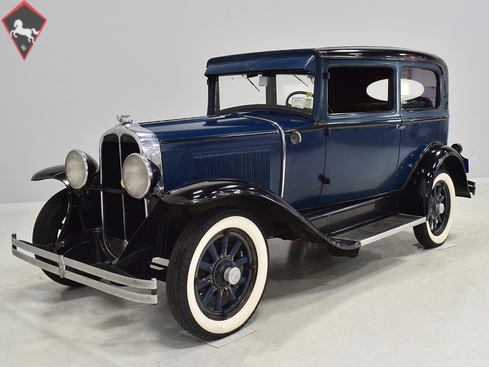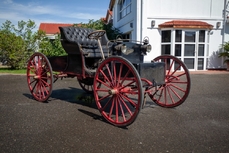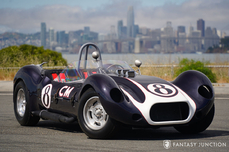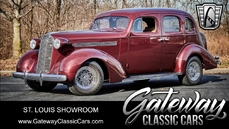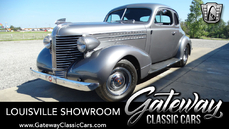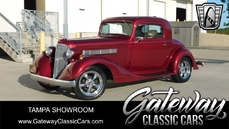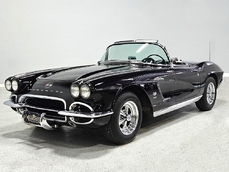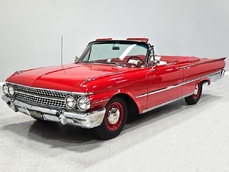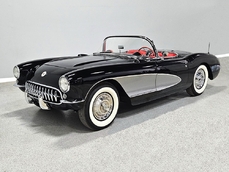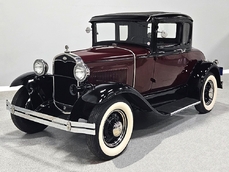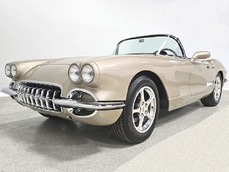Pontiac Other 200 cubic inch inline-6 1930
Allgemeine Beschreibung :
Old cars are interesting for a variety of reasons, but almost everyone can agree that they represent history in a very tangible way that’s appealing. This 1930 Pontiac “Big Six” two-door sedan is one of those special cars that brings a great story to go with its handsome good looks. Most importantly, it’s quite original and carries an AACA HPOF award to back it up. It has had just three owners in its 88-year lifetime, and that’s an interesting story all by itself. It was purchased new by Richard M. Carlson, who kept it until 1961, a remarkable 30 years. He might have even kept it longer, except a local kid at the gas station in town kept pestering him. “Mr. Carlson, I’d sure like to buy that car,” he would say every time the Pontiac showed up for gas. Eventually, Mr. Carlson relented, and that 16-year-old kid became the car’s second owner. And unlike most 16-year-old kids of the 1960s, he wasn’t interested in hot-rodding or racing the Pontiac, he liked it just the way it was. He used his skills learned at the gas station to keep the Poncho in top condition, enjoying it for more than two decades when, in 1982, it was purchased by its third and most recent owner. Along the way, they amassed a rather significant collection of paperwork and books on the car, plus a large cache of spare parts to keep it in top condition. If any car has been loved, it’s this handsome blue Pontiac.
All of that is completely true, but the really amazing thing is just how nice this Pontiac really is. It’s almost entirely original—an important part of the HPOF award is the “preservation” thing. That’s original Seminole Blue paint on the body and it has a wonderful soft shine that only comes from age and lots of polishing. A few areas of the black fenders and on the roof have started to crack and chip, but as an original car, it would be a mistake to chase perfection here. We’ve found that original cars, warts and all, seem to attract much more attention than shiny new cars—yes, it’s a change in your mindset, but it’s a worthy one because you’ll find cars like this have a great many admirers. There’s just nothing like the precision sound the doors make when they close, the warm tone of the polished chrome radiator shell and bumpers, and the feeling that you could reach back through time just by sitting in the passenger’s seat. This car has been used as a benchmark for judging standards in the Pontiac-Oakland Club International (POCI) and it retains all its original fittings, from the Chief Pontiac hood ornament to the just-barely-visible “PONTIAC” lettering on the running boards to the single taillight out back. Even the spare tire cover appears to be an accessory installed by the original dealer at Mr. Carlson’s request and we’re betting that’s the original spare tire underneath—it’s ancient!
The beautifully outfitted interior still carries vintage 1930 olive-colored mohair, a popular and surprisingly durable material that was a staple throughout the GM line (the same stuff is in my 1929 Cadillac). Two buckets up front offer good access to the rear bench and aside from a few split seams along the back of the driver’s seat, the upholstery is in fantastic shape. Floor coverings are simple rubber mats over plywood floors, just as when it was new, and it’s somewhat surprising to see that the map pockets still have a bit of elastic left in them. Nice! The simple flat instrument panel has all its original gauges and knobs, as well as a long list of accessories: heater, ashtray and lighter, a fan mounted above the driver along with an interesting odometer for setting service intervals, dual rear-view mirrors, plus the primitive turn signal device mounted on the steering column. In lieu of a cowl vent, the windshield cranks upwards and a scoop at the top of the dashboard channels cool air towards your feet and dual windshield wipers were an accessory as well. The rear seat remains in fantastic condition and even includes a silk shade for the oval rear window, a Pontiac styling trademark throughout the ‘30s. It shouldn’t be a surprise that this car has scored as well as it has in preservation class judging.
Pontiac’s rugged and reliable 200 cubic inch “split head” inline-6 runs as well as ever thanks to proper maintenance over the years. Hit the starter and it springs to life easily with a little choke, and it never seems to get fussy. It shows 61,305 miles and we believe that is an authentic reading, so the engine remains healthy and ready to tour. It’s not detailed and perfect, but it’s also evident that this car has been spared the harsh realities of winter weather, because the block is clean, the manifolds show only the usual surface scale, and all the fittings remain bright. A mechanical fuel pump was a recent innovation and has been recently rebuilt, as has the updraft carburetor, and the ignition system was recently treated to points, condenser, wires, and plugs. You’ll note that the electrical system has been upgraded to an external regulator, which is a clever idea that works well here, and there’s an accessory oil filter on the firewall. Cruising speeds are an easy 45-50 MPH, although it’ll do more without complaint if you’re in a hurry. It has a pleasing six-cylinder sound and the inline-six remains eminently smooth whenever it’s working. This is a really easy car to drive!
Part of that comes from the 3-speed manual transmission, which has GM’s Synchro-Mesh to make shifting easy and smooth. It works as advertised and feels quite contemporary with no double-clutching needed. As an original car, the underside isn’t detailed and shiny, but with wooden floors, a frame made of 3/16-inch thick steel, and heavy-duty hardware, rust is a non-issue. The brakes are mechanical, so you’ll need a little planning, but they’re effective if you drive the car within its limits. The same goes for the steering and handling, and this Pontiac offers a big car ride at a Model A price—there’s just no comparison. In fact, after driving this car, I realized something was amiss with my 1929 Cadillac’s springs because the Pontiac rode so much better (it turns out my Cadillac springs were stuck together). Wood spoke wheels were painted in 1930 instead of natural, an updated look that certainly helps clean up the styling, and it carries appropriate G-100 Goodyear wide whitewalls that the 16-year-old kid probably installed sometime during the Johnson administration.
Extras include a huge folder of period Pontiac literature, advertisements, and service manuals, plus receipts from the car’s extensive history. We also have dozens of service parts, spares, lights, lenses, wiring, and just cool vintage stuff like ancient Quaker State oil cans (remember those?). There’s even a spare transmission, should you ever need it.
This is an easy car to enjoy. The originality is extremely appealing, yet very low maintenance. The engine is simple and rugged, but 50% more powerful than a comparable Model A Ford. There’s a level of sophistication to the Big Six that other cars in its price range—then and now—don’t quite match. And with history on its side, you’ll have the honor of being the next chapter in this Pontiac’s story. Will you own it for decades like the others? Only time will tell, so call today!
http://www.harwoodmotors.com/vehicles/inventory_details.php?id=978
1930 Pontiac Other 200 cubic inch inline-6 is listed verkauft on ClassicDigest in Macedonia by for $14900.
Fakten der Auto
Karosserietyp : Auto Marke : Pontiac Modell : Other Ausführung : 200 cubic inch inline-6 Hubraum : 0.0 Modelljahr : 1930 Karosstyp : Sedan Lage : Ohio
Verkauft
Angaben Zum Verkäufer
Verkauft
People who viewed this Pontiac Other also viewed similar Pontiac listed at ClassicDigest
Other cars listed for sale by this dealer
über Pontiac
Pontiac, eine Abteilung von General Motors (GM), hatte eine unverwechselbare Position in der Hierarchie des Unternehmens und spielte eine wichtige Rolle in der Automobilgeschichte. Hier ist ein Überblick über die Geschichte von Pontiac und einige seiner bekanntesten Modelle bis in die 1980er Jahre:Position in GM -Hierarchie:
Eindeutige Identität: Pontiac nahm einen einzigartigen Ort innerhalb von GM ein, der für seine leistungsorientierten Fahrzeuge und sein jugendliches Branding bekannt war.
Marke mit mittlerer Ebene: Über Chevrolet positioniert, aber unter den gehobeneren Abteilungen wie Oldsmobile, Buick und Cadillac, Pontiac, wollte erschwingliche und doch sportliche Autos anbieten.
Geschichte und bemerkenswerte Modelle:
Pontiac GTO (1964-1974):
Ikone Muscle Car: Als erster echtes amerikanisches Muscle -Car betrachtet, mischt es Leistung und Stil.
Spezifikationen: V8 -Motoren, starke Leistung und aggressives Styling machten den GTO immens beliebt.
Pontiac Firebird (1967-1981):
Muscle Car und Pony Car: teilte die Plattform mit dem Chevrolet Camaro mit unterschiedlichen Pontiac -Styling -Hinweisen.
Varianten: boten verschiedene Modelle und Motoroptionen an, einschließlich des Trans Am, der durch Filme wie "Smokey und The Bandit" Ruhm erlangte.
Pontiac Grand Prix (1962-2008):
Persönliches Luxusauto: Zunächst ein Auto in voller Größe, das später in ein mittelgroßes Modell verwandelt wird, das für seine Mischung aus Komfort und Leistung bekannt ist.
Evolution: Im Laufe der Jahre wechselte es von einem leistungsorientierten Auto zu einem luxuriöseren Angebot.
Pontiac Bonneville (1957-2005):
Flaggschiff-Modell: Als ein Auto in voller Größe begonnen und sich zu einem luxuriösen und technologisch fortschrittlichen Fahrzeug entwickelt.
Innovation: Bekannt für die Einführung von Merkmalen wie Kraftstoffeinspritzung, was es zu einem Symbol für Pontiacs technologische Fortschritte macht.
Auswirkung und Erbe:
Performance Image: Pontiac hat sich eine Nische geschafft, indem er Leistung, Sportlichkeit und Innovation hervorhebt und jüngere und begeisterte Fahrer anzieht.
Marketingerfolg: Innovative Marketingstrategien und erfolgreiche Rennbemühungen trugen zur Beliebtheit und Markenimage von Pontiac bei.
Produktionsabschluss: Leider hat GM aufgrund finanzieller Einschränkungen und Änderungen der Verbraucherpräferenzen die Marke Pontiac im Jahr 2010 eingestellt und das Ende seines Erbes in der Automobilindustrie kennzeichnet.
